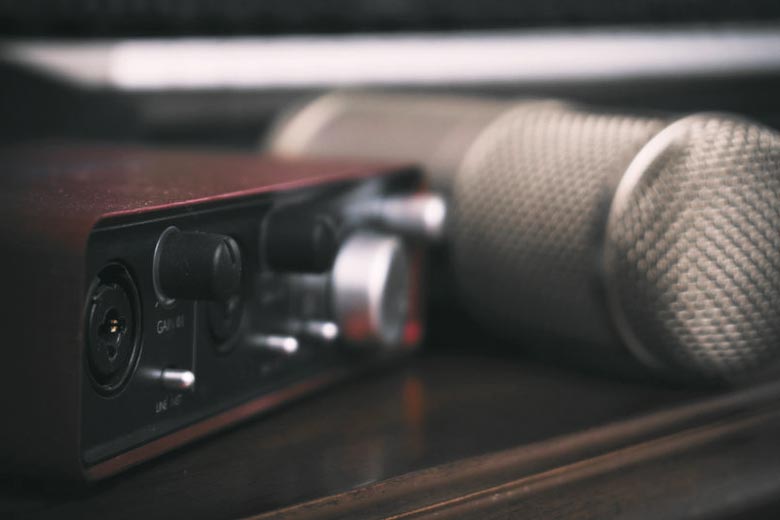If you’re into audio recording but not an expert on it, you know how stressful working with audio equipment can get. Plugging your condenser mic into an audio interface may seem easy but the result may differ depending on your equipment. So, do all audio interfaces have built-in phantom power to support condenser microphones?
Most audio interfaces have built-in phantom power, which supplies power to any microphone connected to the interface. However, some audio interfaces don’t have built-in phantom power. If you’re using a condenser microphone, you may need to get a dedicated phantom power supply.
This post will define phantom power, how it works, and whether you need it. I’ll also answer if it’s possible to connect a phantom power supply to your audio interface and, if yes, how.

What Is Phantom Power?
Condenser and dynamic microphones have different working mechanisms. However, one significant trait they share is how they receive operating power from the mixer, amp, or preamp. That said, what is even phantom power, and how does it work?
Phantom power is the 12V/48V DC power supplied to condenser microphones. This electrical power is sent to the microphone through the XLR cable to power the microphone’s active internal circuitry. Condenser microphones can’t work without phantom power.
The mixing console or preamplifier usually provides the phantom power supply (if you don’t have a dedicated phantom power supply). Condenser microphones require phantom power to operate, but most dynamic microphones don’t.
Some mixer consoles have an on/off switch for phantom power, while others automatically provide phantom power when a condenser microphone is plugged into the mic input.
A few preamplifiers have their own phantom power supply so that you can use them with dynamic microphones as well as condenser microphones.
Related article: Audio Interface vs. Mixer: Which Is Right for You?
How Does Phantom Power Work?
As mentioned earlier, phantom power is a convenient way to supply power to a microphone’s internal circuitry. It’s also an important safety feature for your microphones since it eliminates the need for batteries or external power supplies. But how does it work?
Phantom power works by sending a DC current down the audio cable to the microphone. This current is converted into AC (alternating current) by the transformer in the microphone. The AC voltage is then sent to the preamplifier or condenser microphone’s polar pattern switch.
Without phantom power, your condenser microphone will only capture inaudible sound or fail to work altogether. If you crank up the microphone to max volume but can barely hear it, even when you’re yelling, you need phantom power.
Related article: Do Wireless Mics Need Phantom Power?
Do I Need a Phantom Power Supply with an Audio Interface?
Different setups have different requirements depending on the nature of the connected devices. For instance, you don’t need phantom power if your dynamic microphone can capture sound without it.
On the other hand, audio interfaces are essential since they convert analog signals from your instrument or mic into a digital signal your computer can recognize.
You need a phantom power supply with an audio interface if you have a condenser microphone with built-in circuitry. Conversely, you don’t need a phantom power supply with a dynamic microphone. An audio interface is a must-have device — it’s a critical communication channel between instruments/microphones and computers.
The phantom power that’s found in most microphones is vital for a couple of reasons:
- Provides power to the microphone sound elements.
- Phantom power allows the microphone to work with a wide range of input devices, both professional and consumer-grade.
- Phantom power ensures that your microphone will always sound its best.
The purpose of phantom power is to provide power to the condenser microphone’s capsule. The voltage supplied depends on the microphone and the system it’s being used with. It’s crucial to ensure that the phantom power is turned on when using a condenser microphone. Otherwise, you won’t get any audible sound from it.
Can I Connect Phantom Power to an Audio Interface?
You’re probably wondering if it’s possible to add phantom power to your current audio interface to avoid having to buy a new one. And if your audio interface already has phantom power, there’s a concern that you might accidentally fry the circuitry if you try plugging in a dedicated phantom power supply.
You can connect phantom power to an audio interface. However, you should be aware of a few things before doing so. Phantom power is used to supply power to condenser microphones, and many audio interfaces don’t have that kind of input.

First of all, not all audio interfaces have phantom power capabilities. So, before connecting anything, be sure to check your audio interface’s specifications to make sure it supports this type of input.
There’s no harm in trying to hook up phantom power to your audio interface, but you likely won’t be able to. You might be able to find an adapter that can work, but it’s not guaranteed that it’ll work.
If you’re determined to use a condenser microphone, your best bet is to purchase an audio interface with built-in phantom power.
Also, keep in mind that phantom power can drain your battery faster. If you’re using an external battery pack to power your audio interface, you may want to adjust the settings, so that phantom power isn’t being used if not needed.
How To Connect Your Phantom Power Supply
Connecting your phantom power supply isn’t as complicated as it sounds. All you need to do is plug the phantom power supply into an outlet and then connect the microphone cable to the power supply and the microphone. That’s it! You’re ready to start using your phantom power supply.
And here are the steps to do it:
1. Check Your Microphone Cable
Most phantom power supplies come with various cables that you can use to connect them to different types of microphones.
So, make sure to check the specifications of your phantom power supply to see which cables are included.
If you need to purchase a cable separately, get the correct cable type for your microphone.
Related article: 11 Cables You May Need for an Audio Interface
2. Connect the Phantom Power Supply to Your Microphone
Once you’ve connected the phantom power supply to your microphone, turn on the power switch on the supply.
Then, turn on your microphone by turning on the power switch on the microphone. The power switch on the microphone will usually be located on the back of the microphone.
3. Adjust the Level of Phantom Power Going Into Your Mic
Once your phantom power supply and microphone are turned on, you should see the level of phantom power delivered to the microphone by looking at the level indicator on the phantom power supply.
The level indicator will usually be a red or green light. If the light is green, it means that the phantom power supply is delivering the correct amount of power to the microphone. If the light is red, it means that the phantom power supply is delivering too much power to the microphone, so you should turn down the power level knob.
Remember, make sure that your microphone is compatible with phantom power before you try using a phantom power supply. Not all microphones can handle the extra voltage, so double-check that your microphone is compatible before making any connections.
Related article: Can Phantom Power Pass Through TRS?
Final Thoughts
Audio interfaces have built-in phantom power for condenser microphones. If you’re not sure how to connect your phantom power supply, or if you have any other questions about using this type of power supply, be sure to consult the instructions that came with your power supply.
And if you still have questions after reading the instructions, contact the manufacturer of your power supply for more help.